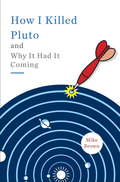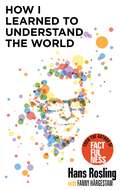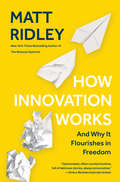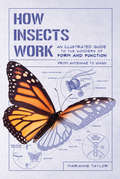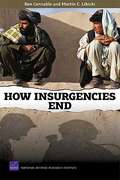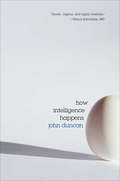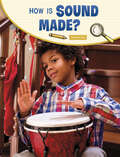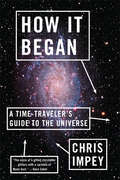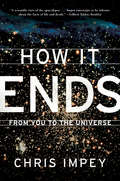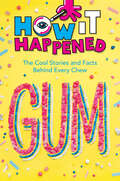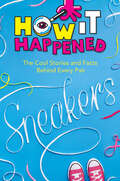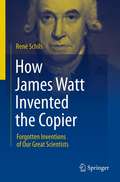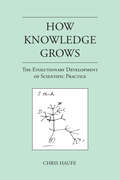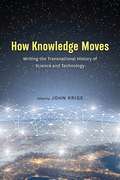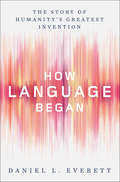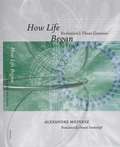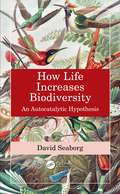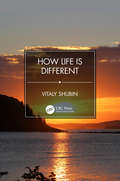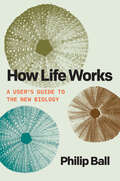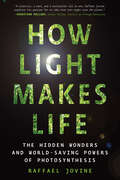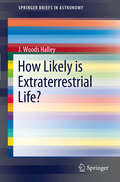- Table View
- List View
How I Killed Pluto and Why It Had It Coming
by Mike BrownThe solar system most of us grew up with included nine planets, with Mercury closest to the sun and Pluto at the outer edge. Then, in 2005, astronomer Mike Brown made the discovery of a lifetime: a tenth planet, Eris, slightly bigger than Pluto. But instead of its resulting in one more planet being added to our solar system, Brown's find ignited a firestorm of controversy that riled the usually sedate world of astronomy and launched him into the public eye. The debate culminated in the demotion of Pluto from real planet to the newly coined category of "dwarf" planet. Suddenly Brown was receiving hate mail from schoolchildren and being bombarded by TV reporters--all because of the discovery he had spent years searching for and a lifetime dreaming about. Filled with both humor and drama, How I Killed Pluto and Why It Had It Coming is Mike Brown's engaging first-person account of the most tumultuous year in modern astronomy--which he inadvertently caused. As it guides readers through important scientific concepts and inspires us to think more deeply about our place in the cosmos, it is also an entertaining and enlightening personal story: While Brown sought to expand our understanding of the vast nature of space, his own life was changed in the most immediate, human ways by love, birth, and death. A heartfelt and personal perspective on the demotion of everyone's favorite farflung planet, How I Killed Pluto and Why It Had It Coming is the book for anyone, young or old, who has ever dreamed of exploring the universe--and who among us hasn't?From the Hardcover edition.
How I Learned to Understand the World: BBC RADIO 4 BOOK OF THE WEEK
by Hans RoslingThis is a book that contains very few numbers. Instead, it is about meeting people who have opened my eyes.It was facts that helped him explain how the world works. But it was curiosity and commitment that made the late Hans Rosling, author of worldwide bestseller Factfulness, the most popular researcher of our time.How I Learned to Understand the World is Hans Rosling's own story of how a young scientist learned became a revolutionary thinker, and takes us from the swelter of an emergency clinic in Mozambique, to the World Economic Forum at Davos. In collaboration with Swedish journalist Fanny Härgestam, Hans Rosling wrote his memoir with the same joy of storytelling that made a whole world listen when he spoke.
How I Learned to Understand the World: BBC RADIO 4 BOOK OF THE WEEK
by Hans RoslingThis is a book that contains very few numbers. Instead, it is about meeting people who have opened my eyes.It was facts that helped him explain how the world works. But it was curiosity and commitment that made the late Hans Rosling, author of worldwide bestseller Factfulness, the most popular researcher of our time.How I Learned to Understand the World is Hans Rosling's own story of how a young scientist learned became a revolutionary thinker, and takes us from the swelter of an emergency clinic in Mozambique, to the World Economic Forum at Davos. In collaboration with Swedish journalist Fanny Härgestam, Hans Rosling wrote his memoir with the same joy of storytelling that made a whole world listen when he spoke.(P) 2020 Hodder & Stoughton Ltd
How Innovation Works: And Why It Flourishes in Freedom
by Matt RidleyBuilding on his national bestseller The Rational Optimist, Matt Ridley chronicles the history of innovation, and how we need to change our thinking on the subject.Innovation is the main event of the modern age, the reason we experience both dramatic improvements in our living standards and unsettling changes in our society. Forget short-term symptoms like Donald Trump and Brexit, it is innovation that will shape the twenty-first century. Yet innovation remains a mysterious process, poorly understood by policy makers and businessmen alike.Matt Ridley argues that we need to see innovation as an incremental, bottom-up, fortuitous process that happens as a direct result of the human habit of exchange, rather than an orderly, top-down process developing according to a plan. Innovation is crucially different from invention, because it is the turning of inventions into things of practical and affordable use to people. It speeds up in some sectors and slows down in others. It is always a collective, collaborative phenomenon, involving trial and error, not a matter of lonely genius. It happens mainly in just a few parts of the world at any one time. It still cannot be modeled properly by economists, but it can easily be discouraged by politicians. Far from there being too much innovation, we may be on the brink of an innovation famine.Ridley derives these and other lessons from the lively stories of scores of innovations, how they started and why they succeeded or failed. Some of the innovation stories he tells are about steam engines, jet engines, search engines, airships, coffee, potatoes, vaping, vaccines, cuisine, antibiotics, mosquito nets, turbines, propellers, fertilizer, zero, computers, dogs, farming, fire, genetic engineering, gene editing, container shipping, railways, cars, safety rules, wheeled suitcases, mobile phones, corrugated iron, powered flight, chlorinated water, toilets, vacuum cleaners, shale gas, the telegraph, radio, social media, block chain, the sharing economy, artificial intelligence, fake bomb detectors, phantom games consoles, fraudulent blood tests, hyperloop tubes, herbicides, copyright, and even life itself.
How Insects Work: An Illustrated Guide to the Wonders of Form and Function—from Antennae to Wings
by Marianne TaylorThe extraordinary inner-workings of the world&’s amazing, adaptable insectsA tiny textbook to learn on your ownHow Insects Work goes beyond the typical field guide to show us not only what insects look like but why. Arguably the most successful land animals—still going strong after five mass extinctions—insects have evolved a spectacular array of real-life superpowers to help them thrive in virtually every environment: Bumblebees&’ wingbeats leave a faint electrical signal at each flower they visit to show that the nectar&’s already been taken (see page 57), and houseflies defy gravity with tiny leg hairs that stick to the smoothest wall or ceiling (see page 69). In this in-depth, photo-filled handbook, discover the ways insects are even more astounding than you know—inside and out: EvolutionExoskeleton and Body SegmentsSensesCirculationDigestionRespirationReproductionMetamorphosisMovementAnd much, much more!
How Insurgencies End
by Martin C. Libicki Ben ConnableRAND studied 89 modern insurgency cases to test conventional understanding about how insurgencies end. Findings relevant to policymakers and analysts include that modern insurgencies last about ten years; withdrawal of state support cripples insurgencies; civil defense forces are useful for both sides; pseudodemocracies fare poorly against insurgents; and governments win more often in the long run.
How Intelligence Happens
by John DuncanA lively journey through the brain&’s inner workings from &“one of the world&’s leading cognitive neuroscientists&” (The Wall Street Journal). Human intelligence builds sprawling cities, vast cornfields, and complex microchips. It takes us from the atom to the limits of the universe. How does the biological brain, a collection of billions of cells, enable us to do things no other species can do? In this book, neuroscientist John Duncan offers an adventure story—the story of the hunt for basic principles of human intelligence, behavior, and thought. Using results drawn from classical studies of intelligence testing; from attempts to build computers that think; from studies of how minds change after brain damage; from modern discoveries of brain imaging; and from groundbreaking recent research, he synthesizes often difficult-to-understand information into clear, fascinating prose about how brains work. Moving from the foundations of psychology, artificial intelligence, and neuroscience to the most current scientific thinking, How Intelligence Happens is &“a timely, original, and highly readable contribution to our understanding&” (Nancy Kanwisher, MIT) from a winner of the Heineken Prize for Cognitive Science
How Is a Crayon Made?
by Oz CharlesEver wonder how crayons are made? Find out about all the steps that go into making your favorite crayons in this book!
How Is Sound Made? (Science Inquiry)
by Emily RaijSounds can be loud. Sounds can be soft. We use our ears to hear all kinds of sounds. But how is sound made? Let’s investigate to find out about sound!
How Isaac Newton Lost His Marbles: And more medical mysteries, marvels and mayhem
by George Biro Jim Leavesley Greg Smith50 intriguing stories of famous patients, doctors, medical experiments, disasters and triumphs.
How It Began: A Time-Traveler's Guide to the Universe
by Chris Impey"Impey combines the vision of a practicing scientist with the voice of a gifted storyteller."--Dava Sobel In this vibrant, eye-opening tour of milestones in the history of our universe, Chris Impey guides us through space and time, leading us from the familiar sights of the night sky to the dazzlingly strange aftermath of the Big Bang. What if we could look into space and see not only our place in the universe but also how we came to be here? As it happens, we can. Because it takes time for light to travel, we see more and more distant regions of the universe as they were in the successively greater past. Impey uses this concept--"look-back time"--to take us on an intergalactic tour that is simultaneously out in space and back in time. Performing a type of cosmic archaeology, Impey brilliantly describes the astronomical clues that scientists have used to solve fascinating mysteries about the origins and development of our universe. The milestones on this journey range from the nearby to the remote: we travel from the Moon, Jupiter, and the black hole at the heart of our galaxy all the way to the first star, the first ray of light, and even the strange, roiling conditions of the infant universe, an intense and volatile environment in which matter was created from pure energy. Impey gives us breathtaking visual descriptions and also explains what each landmark can reveal about the universe and its history. His lucid, wonderfully engaging scientific discussions bring us to the brink of modern cosmology and physics, illuminating such mind-bending concepts as invisible dimensions, timelessness, and multiple universes. A dynamic and unforgettable portrait of the cosmos, How It Began will reward its readers with a deeper understanding of the universe we inhabit as well as a renewed sense of wonder at its beauty and mystery.
How It Ends: From You to the Universe
by Chris Impey"Remarkably upbeat, and imbued with wit, wisdom and a palpable sense of awe over our universe."--Tucson Weekly Most of us are aware of our own mortality, but few among us know what science, with insights yielded from groundbreaking new research, has to say about endings on a larger scale. Enter astronomer Chris Impey, who chronicles the death of the whole shebang: individual, species, bio- sphere, Earth, Sun, Milky Way, and, finally, the entire universe. With a healthy dose of humor, How It Ends illuminates everything from the technologies of human life extension and the evolutionary arms race between microbes and men to the inescapable dimming of the Sun and the ultimate "big rip," giving us a rare glimpse into a universe without us.
How It Happened! Gum: The Cool Stories and Facts Behind Every Chew (How It Happened)
by Paige Towler WonderLab GroupFind out how gum became everyone&’s favorite chewing candy in this fact-filled nonfiction book, part of the How It Happened! series. Baseball stadiums, movie theaters, underneath your desk at school—gum is everywhere. But how did this gluey glob become everyone&’s favorite candy to chomp on? Readers will love gobbling down the story of gum, from its ancient origins to its influence on &“pop&” culture . . . and everything in between!
How It Happened! Sneakers: The Cool Stories and Facts Behind Every Pair (How It Happened)
by Stephanie Warren Drimmer WonderLab GroupFind out how sneakers took over the world in this fact-filled nonfiction book, part of a series about the stories behind cool objects! From going to school to shopping at the mall, sneakers are one of the most comfortable ways to get around. But how did these rubbery soles become everyone&’s favorite shoe to stomp in? Readers will love learning about the story behind sneakers, from the world&’s oldest shoe to the latest designer sneaker drop . . . and everything in between!
How James Watt Invented the Copier
by René SchilsFeatures 25 different scientists and the ideas which may not have made them famous, but made history...Typically, we remember our greatest scientists from one single invention, one new formula or one incredible breakthrough. This narrow perspective does not give justice to the versatility of many scientists who also earned a reputation in other areas of science. James Watt, for instance, is known for inventing the steam engine, yet most people do not know that he also invented the copier. Alexander Graham Bell of course invented the telephone, but only few know that he invented artificial breathing equipment, a prototype of the 'iron lung'. Edmond Halley, whose name is associated with the comet that visits Earth every 75 years, produced the first mortality tables, used for life insurances. This entertaining book is aimed at anyone who enjoys reading about inventions and discoveries by the most creative minds. Detailed illustrations of the forgotten designs and ideas enrich the work throughout.
How Knowledge Grows: The Evolutionary Development of Scientific Practice
by Chris HaufeAn argument that the development of scientific practice and growth of scientific knowledge are governed by Darwin&’s evolutionary model of descent with modification.Although scientific investigation is influenced by our cognitive and moral failings as well as all of the factors impinging on human life, the historical development of scientific knowledge has trended toward an increasingly accurate picture of an increasing number of phenomena. Taking a fresh look at Thomas Kuhn&’s 1962 work, The Structure of Scientific Revolutions, in How Knowledge Grows Chris Haufe uses evolutionary theory to explain both why scientific practice develops the way it does and how scientific knowledge expands. This evolutionary model, claims Haufe, helps to explain what is epistemically special about scientific knowledge: its tendency to grow in both depth and breadth.Kuhn showed how intellectual communities achieve consensus in part by discriminating against ideas that differ from their own and isolating themselves intellectually from other fields of inquiry and broader social concerns. These same characteristics, says Haufe, determine a biological population&’s degree of susceptibility to modification by natural selection. He argues that scientific knowledge grows, even across generations of variable groups of scientists, precisely because its development is governed by Darwinian evolution. Indeed, he supports the claim that this susceptibility to modification through natural selection helps to explain the epistemic power of certain branches of modern science. In updating and expanding the evolutionary approach to scientific knowledge, Haufe provides a model for thinking about science that acknowledges the historical contingency of scientific thought while showing why we nevertheless should trust the results of scientific research when it is the product of certain kinds of scientific communities.
How Knowledge Moves: Writing the Transnational History of Science and Technology
by John KrigeKnowledge matters, and states have a stake in managing its movement to protect a variety of local and national interests. The view that knowledge circulates by itself in a flat world, unimpeded by national boundaries, is a myth. The transnational movement of knowledge is a social accomplishment, requiring negotiation, accommodation, and adaptation to the specificities of local contexts. This volume of essays by historians of science and technology breaks the national framework in which histories are often written. Instead, How Knowledge Moves takes knowledge as its central object, with the goal of unraveling the relationships among people, ideas, and things that arise when they cross national borders. This specialized knowledge is located at multiple sites and moves across borders via a dazzling array of channels, embedded in heads and hands, in artifacts, and in texts. In the United States, it shapes policies for visas, export controls, and nuclear weapons proliferation; in Algeria, it enhances the production of oranges by colonial settlers; in Vietnam, it facilitates the exploitation of a river delta. In India it transforms modes of agricultural production. It implants American values in Latin America. By concentrating on the conditions that allow for knowledge movement, these essays explore travel and exchange in face-to-face encounters and show how border-crossings mobilize extensive bureaucratic technologies.
How Language Began: The Story Of Humanity's Greatest Invention
by Daniel L. EverettHow Language Began revolutionizes our understanding of the one tool that has allowed us to become the "lords of the planet." Mankind has a distinct advantage over other terrestrial species: we talk to one another. But how did we acquire the most advanced form of communication on Earth? Daniel L. Everett, a “bombshell” linguist and “instant folk hero” (Tom Wolfe, Harper’s), provides in this sweeping history a comprehensive examination of the evolutionary story of language, from the earliest speaking attempts by hominids to the more than seven thousand languages that exist today. Although fossil hunters and linguists have brought us closer to unearthing the true origins of language, Daniel Everett’s discoveries have upended the contemporary linguistic world, reverberating far beyond academic circles. While conducting field research in the Amazonian rainforest, Everett came across an age-old language nestled amongst a tribe of hunter-gatherers. Challenging long-standing principles in the field, Everett now builds on the theory that language was not intrinsic to our species. In order to truly understand its origins, a more interdisciplinary approach is needed—one that accounts as much for our propensity for culture as it does our biological makeup. Language began, Everett theorizes, with Homo Erectus, who catalyzed words through culturally invented symbols. Early humans, as their brains grew larger, incorporated gestures and voice intonations to communicate, all of which built on each other for 60,000 generations. Tracing crucial shifts and developments across the ages, Everett breaks down every component of speech, from harnessing control of more than a hundred respiratory muscles in the larynx and diaphragm, to mastering the use of the tongue. Moving on from biology to execution, Everett explores why elements such as grammar and storytelling are not nearly as critical to language as one might suspect. In the book’s final section, Cultural Evolution of Language, Everett takes the ever-debated “language gap” to task, delving into the chasm that separates “us” from “the animals.” He approaches the subject from various disciplines, including anthropology, neuroscience, and archaeology, to reveal that it was social complexity, as well as cultural, physiological, and neurological superiority, that allowed humans—with our clawless hands, breakable bones, and soft skin—to become the apex predator. How Language Began ultimately explains what we know, what we’d like to know, and what we likely never will know about how humans went from mere communication to language. Based on nearly forty years of fieldwork, Everett debunks long-held theories by some of history’s greatest thinkers, from Plato to Chomsky. The result is an invaluable study of what makes us human.
How Life Began: Evolution's Three Geneses
by Alexandre MeineszThe origin of life is a hotly debated topic. The Christian Bible states that God created the heavens and the Earth, all in about seven days roughly six thousand years ago. This episode in Genesis departs markedly from scientific theories developed over the last two centuries which hold that life appeared on Earth about 3.5 billion years ago in the form of bacteria, followed by unicellular organisms half a millennia later. It is this version of genesis that Alexandre Meinesz explores in this engaging tale of life's origins and evolution. How Life Began elucidates three origins, or geneses, of life—bacteria, nucleated cells, and multicellular organisms—and shows how evolution has sculpted life to its current biodiversity through four main events—mutation, recombination, natural selection, and geologic cataclysm. As an ecologist who specializes in algae, the first organisms to colonize Earth, Meinesz brings a refreshingly novel voice to the history of biodiversity and emphasizes here the role of unions in organizing life. For example, the ingestion of some bacteria by other bacteria led to mitochondria that characterize animal and plant cells, and the chloroplasts of plant cells. As Meinesz charmingly recounts, life’s grandeur is a result of an evolutionary tendency toward sociality and solidarity. He suggests that it is our cohesion and collaboration that allows us to solve the environmental problems arising in the decades and centuries to come. Rooted in the science of evolution but enlivened with many illustrations from other disciplines and the arts, How Life Began intertwines the rise of bacteria and multicellular life with Vermeer’s portrait of Antoni van Leeuwenhoek, the story of Genesis and Noah, Meinesz’s son’s early experiences with Legos, and his own encounters with other scientists. All of this brings a very human and humanistic tone to Meinesz’s charismatic narrative of the three origins of life.
How Life Began: Evolution’s Three Geneses
by Alexandre Meinesz Daniel SimberloffThe origin of life is a hotly debated topic. The Christian Bible states that God created the heavens and the Earth, all in about seven days roughly six thousand years ago. This episode in Genesis departs markedly from scientific theories developed over the last two centuries which hold that life appeared on Earth about 3 billion years ago in the form of bacteria, followed by unicellular organisms half a millennia later. It is this version of genesis that Alexandre Meinesz explores in this engaging tale of life's origins and evolution. How Life Began elucidates three origins, or geneses, of life-- bacteria, cells, and multicellular organisms-- and shows how evolution has sculpted life to its current biodiversity through four main events-- mutation, recombination, natural selection, and geologic cataclysm. As an ecologist who specializes in algae, the first organisms to colonize Earth, Meinesz brings a refreshingly novel voice to the history of biodiversity and emphasizes here the role of unions in organizing life. For example, the ingestion of some bacteria by other bacteria led to mitochondria that characterize animal and plant cells, and the chloroplasts of plant cells. As Meinesz charmingly recounts, life's grandeur is a result of an evolutionary tendency toward sociality and solidarity. He suggests that it is our cohesion and collaboration that allows us to solve the environmental problems arising in the decades and centuries to come. Rooted in the science of evolution but enlivened with many illustrations from other disciplines and the arts,How Life Began intertwines the rise of bacteria and multicellular life with Vermeer's portrait of Antoni van Leeuwenhoek, the story of Genesis and Noah, Meinesz's son's early experiences with Legos, and his own encounters with other scientists. All of this brings a very human and humanistic tone to Meinesz's charismatic narrative of the three origins of life.
How Life Increases Biodiversity: An Autocatalytic Hypothesis
by David SeaborgThis book argues that organisms and their interactions create and maximize biodiversity. The evidence for this autocatalytic hypothesis has been collated and integrated into this provocative argument. Natural selection favors the increase of biodiversity. Organisms can be causative agents contributing to major macroevolutionary transitions. Species tend to have a net positive effect on biodiversity. All species are ecosystem engineers. Mutualism and commensalism are common and fundamental, and these coevolved interspecific interactions frequently generate enormous increases in biodiversity. Competition generally does not decrease biodiversity, and often leads to evolutionary innovation. Plants are ecosystem engineers that have made Earth more favorable to life and increased diversity in many ways. Herbivores and predators increase the diversity of the species they consume, and are necessary for ecosystem stability. Decomposers are essential to ecosystem health. All these examples illustrate the focus of this book – that organisms and their interactions stimulate biodiversity, and ecosystems maximize it. Key Features • Describes a hypothesis that life itself generates higher biodiversity • Suggests a highly modified version of the established paradigm in population biology and evolution • Asserts that all species are ecosystem engineers with a net positive effect on biodiversity and their ecosystems • Suggests that mutualism and commensalism are the rule • Presents a novel view likely to elicit deeper discussions of biodiversity Related Titles Dewdney, A. K. Stochastic Communities: A Mathematical Theory of Biodiversity (ISBN 978-1-138-19702-2) Curry, G. B. and C. J. Humphries, eds. Biodiversity Databases: Techniques, Politics, and Applications (ISBN 978-0-367-38916-1) Pullaiah, T, ed. Global Biodiversity. 4 Volume Set (ISBN 978-1-77188-751-9)
How Life is Different
by Vitaly ShubinThe book examines basic principles of the structure and organization of living organisms and their differences from objects of inanimate nature. It covers how a single program-information structure permeates all evolutionary stages of life, including the cell, multicellular organisms and humans. The author explains how this structure is arranged and how it functions, as well as the role of the information system. KEY FEATURES Reviews persistent questions and addresses fundamental themes in biology Provides systematic coverage Includes original insights into basic principles of living organization and structure Demonstrates the applicability of a proposed approach to particular evolutionary grades RELATED TITLES J.W. Schopf, Life in Deep Time: Darwin’s "Missing" Fossil Record (ISBN 978-1-138-38549-8) C.H. Waddington, ed., The Origin of Life: Toward a Theoretical Biology (ISBN 978-0-202-36302-8) J. Wiegel, A.W.W. Michael, eds., Thermophiles: The Keys to the Molecular Evolution and the Origin of Life (ISBN 978-0-7484-0747-7)
How Life Works: A User’s Guide to the New Biology
by Philip BallA cutting-edge new vision of biology that will revise our concept of what life itself is, how to enhance it, and what possibilities it offers. Biology is undergoing a quiet but profound transformation. Several aspects of the standard picture of how life works—the idea of the genome as a blueprint, of genes as instructions for building an organism, of proteins as precisely tailored molecular machines, of cells as entities with fixed identities, and more—have been exposed as incomplete, misleading, or wrong. In How Life Works, Philip Ball explores the new biology, revealing life to be a far richer, more ingenious affair than we had guessed. Ball explains that there is no unique place to look for an answer to this question: life is a system of many levels—genes, proteins, cells, tissues, and body modules such as the immune system and the nervous system—each with its own rules and principles. How Life Works explains how these levels operate, interface, and work together (most of the time). With this knowledge come new possibilities. Today we can redesign and reconfigure living systems, tissues, and organisms. We can reprogram cells, for instance, to carry out new tasks and grow into structures not seen in the natural world. As we discover the conditions that dictate the forms into which cells organize themselves, our ability to guide and select the outcomes becomes ever more extraordinary. Some researchers believe that ultimately we will be able to regenerate limbs and organs, and perhaps even create new life forms that evolution has never imagined. Incorporating the latest research and insights, How Life Works is a sweeping journey into this new frontier of the life sciences, a realm that will reshape our understanding of life as we know it.
How Light Makes Life: The Hidden Wonders And World-saving Powers Of Photosynthesis
by Raffael JovineA revelatory journey of discovery into the intricate, beautiful, and often surprising processes that convert energy from the sun into life, and how all-important these are to our survival—and our planet’s future It’s a clunky word for a miracle: Photosynthesis. But there’s no life on Earth without it. For biologist Raffael Jovine, it’s a consuming passion, a great unsung force of nature. He makes his case in How Light Makes Life, a catalog of living wonders—and a blueprint for a better planet. Imagine harvesting pure sunlight to use as fuel, while turning carbon dioxide into breathable oxygen. This is what a leaf does every day. And photosynthesis isn’t just for plants: Corals partner with photosynthetic organisms to create the most productive habitat on Earth. Slugs eat chloroplasts as natural green camouflage. Hornets use photosynthesis as an innovative means of air-conditioning—and much more! The revelatory vision of How Light Makes Life is how we ourselves might harness the power of photosynthesis: to repair ecosystems, stabilize the climate, and grow more food sustainably. On this vivid journey, you’ll see how every seed contains the key to our future—through the photosynthetic pigments in your own eyes!
How Likely is Extraterrestrial Life?
by J. Woods HalleyWhat does existing scientific knowledge about physics, chemistry, meteorology and biology tell us about the likelihood of extraterrestrial life and civilizations? And what does the fact that there is currently no credible scientific evidence for the existence of extraterrestrial biospheres or civilizations teach us? This book reviews the various scientific issues that arise in considering the question of how common extraterrestrial life is likely to be in our galaxy and whether humans are likely to detect it. The book stands out because of its very systematic organization and relatively unbiased treatment of the main open question. It covers all relevant aspects of many disciplines required to present the different possible answers. It has and will provide undergraduates with a stimulating introduction to many of these fields at an early stage in their university careers, when they are still choosing a specialty. The difficulties and the range of possible answers to the title question are carefully addressed in the light of present understanding. The resulting perspective is distinctly different from those suggested by most other books on this topic.
